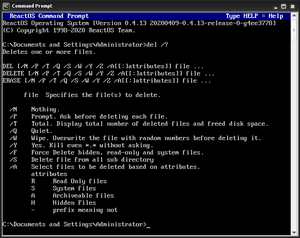del (command)
In computing, del (or erase) is a command in command-line interpreters (shells) such as COMMAND.COM, cmd.exe, 4DOS, NDOS, 4OS2, 4NT and Windows PowerShell. It is used to delete one or more files or directories from a file system.
 The ReactOS del command | |
| Developer(s) | DEC, Microware, Microsoft, IBM, DR, Novell, JP Software, ReactOS Contributors |
|---|---|
| Operating system | RT-11, RSX-11, OS/8, OpenVMS, DOS, OS-9, MSX-DOS, FlexOS, SISNE plus, OS/2, Windows, ReactOS, KolibriOS, SymbOS, DexOS |
| Type | Command |
Implementations
The command is available for various operating systems including DOS, Microware OS-9,[1] IBM OS/2,[2] Microsoft Windows[3] and ReactOS.[4] It is analogous to the Unix rm command and to the Stratus OpenVOS delete_file and delete_dircommands.[5]
DEC RT-11,[6] RSX-11, OS/8[7] and OpenVMS[8] also provide the delete command which can be contracted to del. AmigaDOS[9] and TSC FLEX[10] provide a delete command as well.
The erase command is supported by Tim Paterson's SCP 86-DOS.[11] On MS-DOS, the command is available in versions 1 and later.[12] It is also available in the open-source MS-DOS emulator DOSBox.
While DR-DOS supports del and erase as well, it also supports the shorthand form era, which derived from CP/M. In addition to this, the DR-DOS command processor also supports delq/eraq. These are shorthand forms for the del/era/erase command with an assumed /Q parameter (for 'Query') given as well.[13]
THEOS/OASIS[14] and FlexOS[15] provide only the erase command.
In PowerShell, del and erase are predefined command aliases for the Remove-Item cmdlet which basically serves the same purpose.
Syntax
del filename
erase filename
References
- Paul S. Dayan (1992). The OS-9 Guru - 1 : The Facts. Galactic Industrial Limited. ISBN 0-9519228-0-7.
- http://www.jatomes.com/Help/Os2Cmd.php#ERASE
- https://docs.microsoft.com/en-us/previous-versions/windows/it-pro/windows-server-2012-R2-and-2012/cc771049(v%3dws.11)
- https://github.com/reactos/reactos/blob/master/base/shell/cmd/del.c
- http://stratadoc.stratus.com/vos/19.1.0/r098-19/wwhelp/wwhimpl/common/html/r098-19.pdf
- http://paleoferrosaurus.com/beta/documents/rt11help.html#DELETE
- "Concise Command Language" (CCL)."OS/8 Handbook" (PDF). April 1974. Retrieved 28 November 2017.
- OpenVMS User's Manual
- https://archive.org/details/1988-rugheimer-spanik-amigados-quick-reference
- FLEX 2.0 User's Manual
- 86-DOS - Disk Operating System for the 8086 - User's Manual (PDF). Version 0.3 (Preliminary ed.). Seattle, Washington, USA: Seattle Computer Products, Inc. 1980. Archived from the original (PDF) on 2019-07-14. Retrieved 2019-07-14. (59 pages)
- Wolverton, Van (2003). Running MS-DOS Version 6.22 (20th Anniversary Edition), 6th Revised edition. Microsoft Press. ISBN 0-7356-1812-7.
- DR DOS 6.0 User Guide Optimisation and Configuration Tips
- THEOS/OASIS User′s Handbook
- http://www.bitsavers.org/pdf/digitalResearch/flexos/1073-2003_FlexOS_Users_Guide_V1.3_Nov86.pdf
Further reading
- Wolverton, Van (1990). MS-DOS Commands: Microsoft Quick Reference, 4th Revised edition. Microsoft Press. ISBN 978-1556152894.
- Kathy Ivens; Brian Proffit (1993). OS/2 Inside & Out. Osborne McGraw-Hill. ISBN 978-0078818714.
- Frisch, Æleen (2001). Windows 2000 Commands Pocket Reference. O'Reilly. ISBN 978-0-596-00148-3.